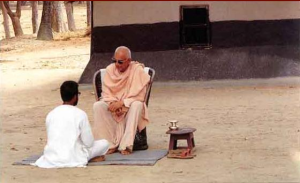
Guru and Sadhaka
Parampara is knowledge that is passed in succession from teacher to student, in other words from the Guru (the master) to the Sadhaka (the disciple). Parampara is a Sanskrit word that denotes the principle of transmitting knowledge in its most valuable form; knowledge based on direct and practical experience. It is the basis of any lineage: the teacher and student form the links in the chain of instruction that has been passed down for thousands of years. In order for yoga instruction to be effective, true and complete, it should come from within parampara.
Knowledge can be transferred only after the student has spent many years with an experienced guru, a teacher to whom he has full confidence and apply his teachings in body, mind, speech and inner being. Only then this transfer of knowledge from teacher to student will be effective, that is parampara.
The dharma, or duty, of the student is to practice diligently and to strive to understand the teachings of the guru. The perfection of knowledge – and of yoga — lies beyond simply mastering the practice; knowledge grows from the mutual love and respect between student and teacher, a relationship that can only be cultivated over time, with humility and gratitude.
The yoga tradition exists in many ancient lineages, but today some are trying to create new ones, renouncing or altering their guru’s teachings in favor of new ways. Surrendering to parampara, however, is like entering a river of teachings that has been flowing for thousands of years, a river that age-old masters have followed into an ocean of knowledge. Even so, not all rivers reach the ocean, so one should be mindful that the tradition he or she follows is true and selfless.
Many attempt to scale the peaks in the Himalayas, but not all succeed. Through courage and surrender, however, one can scale the peaks of knowledge by the grace of the guru, who is the holder of knowledge, and who works tirelessly for his students.
Only the gratitude of the disciple allows the true upliftment and openness of the heart. There are only disciples teaching other disciples … The Guru is within.
We are teaching here the yoga of Patanjali PATANJALA YOGA SHALA

Patanjali
Patanjali is the author of Yoga Sutra, yoga reference text. Yoga is one of six Darshana of Hindu philosophical system.
The text we are referring here in four chapter describes what yoga is, his processing, his powers and his release. We invite you to study this text with a qualified teacher.
Here is the system described in the Sutra of Patanjali :
ASHTANGA YOGA
The term Ashtanga Yoga derives from the Sanskrit words Astau meaning eight and Anga meaning limb. Ashtanga Yoga refers to the eight limbs as taught by the great sage Patanjali who was the first to systematize an approach to classical Yoga in his Yoga Sutra. It can be called also Raja Yoga (Royal Yoga).
These limbs are steps through which the practitioner can progress to reach a state of Yoga or self-realization. The beauty of the eight limbs is that they teach us to integrate all aspects of Yoga. They are all interrelated and can be practised simultaneously, but they also map out a logical progression in which each limb prepares the practitioner for the next.
1 – YAMA the 5 ethics: Ahimsa (non-violence), Satya (truthfulness), Asteya (non-stealing), Brahmacharaya (control of vital energy), Aparigraha (freedom from possession beyond one’s needs).
2 – NIYAMA the 5 disciplines: Saucha (purity of body and mind), Santosha (contentment), Tapas (austerity, self discipline, conscious effort to achieve one’s aim), Svadhyaya (self- study), Isvarapranidhana (surrender to the Divine).
3 – ASANA The physical practice many westerners associate with Yoga. The Asanas are designed to purify, balance and stabilize the body and the energy channels to allow the breath and Prana (life-force) to move freely. In reality Asana means sitting posture.
4 – PRANAYAMA These yogic breathing techniques teach us to harness, direct and channel the pranic energy.
5 – PRATYAHARA the fith limb or ‘the bridge’ between external and internal Yoga. Pratyahara is when the senses begin to turn inwards rather than constantly search for external gratification and stimuli.
The three last limbs are also called Samyama.
6 – DHARANA Concentration.
7 – DHYANA Meditative state.
8 – SAMADHI Dissolution, blossoming, bliss, beatitude, contemplation, enstase.
The Samyama are allowed to naturally unfold as we become established in the first five limbs.
